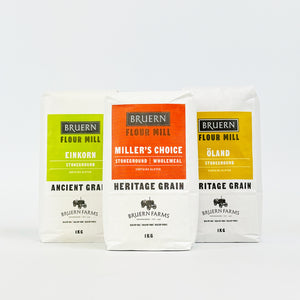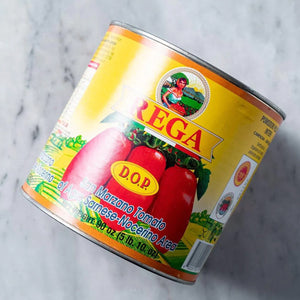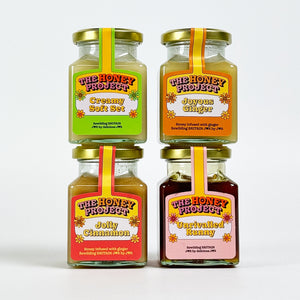
Your complete Sourdough Starter guide + Sourdough Starter recipe.
Are you a bread lover? Do you enjoy the tangy flavour and chewy texture of sourdough bread? If so, then you may be interested in learning about sourdough starter. In this article, we will explore everything you need to know about sourdough starter, from what it is to how to make and maintain it. Let's dive in!
What is sourdough starter?
Sourdough starter is a mixture of flour and water that has been fermented by wild yeast and bacteria. It is used as a leavening agent in sourdough bread, giving it its distinct flavour and texture. The wild yeast and bacteria present in the starter break down the carbohydrates in the flour, producing carbon dioxide gas, which causes the bread to rise.
What is the best flour for making a sourdough starter?
When creating a sourdough starter, it's common to use whole grain flours initially, as they tend to provide a more favourable environment for capturing wild yeast and bacteria. Whole grain flours contain more nutrients and microorganisms that can support the fermentation process. Here are some popular choices for creating a sourdough starter:
Wholewheat/Wholegrain/Wholemeal Flour
Whole wheat flour is a popular choice for starting a sourdough culture. It contains more nutrients and microbial content than refined flours, providing a richer environment for capturing wild yeast.
Whole rye flour is another excellent option for building a sourdough starter. It has a high microbial content and can contribute to a robust and active culture.
Whole spelt flour is less commonly used but can be suitable for creating a sourdough starter. It has a distinct flavor and nutritional profile that some bakers appreciate.
While whole grain flours are commonly recommended for the initial stages of a sourdough starter, once the starter is established and consistently active, you can transition to using all-purpose flour or bread flour if desired. Some bakers also maintain their starters with a combination of whole grain and all-purpose or bread flour for a balance of nutrients and desirable characteristics.
Keep in mind that the specific flour choice may depend on personal preferences and regional availability. Additionally, it's essential to use non-chlorinated water when creating a sourdough starter, as chlorine can inhibit the growth of beneficial microorganisms.
How to make sourdough starter
Making sourdough starter is a simple process that requires just two ingredients: flour and water. Here's a step-by-step guide:
- Combine equal parts of flour and water in a clean container.
- Stir the mixture until well combined.
- Cover the container loosely with a clean cloth or plastic wrap.
- Let the mixture sit at room temperature for 24 hours.
- After 24 hours, discard half of the mixture and feed it with equal parts of fresh flour and water.
- Repeat the process of discarding half and feeding every 24 hours for about a week, or until the starter becomes active and bubbly.
How to maintain sourdough starter
Once your sourdough starter is active, it's important to maintain it properly to keep it healthy and active. Here are some tips:
- Feed your starter regularly by discarding half and feeding it with fresh flour and water.
- Keep your starter in a clean container and cover it loosely to allow for gas exchange.
- Store your starter in the refrigerator when not in use. Feed it once a week to keep it alive.
- If you're not planning to use your starter for an extended period, you can dry it or freeze it for later use.

Benefits of using sourdough starter
Using sourdough starter in your bread baking has several benefits:
- Sourdough bread has a lower glycemic index compared to bread made with commercial yeast, making it a better option for blood sugar control.
- The fermentation process in sourdough starter breaks down gluten, making it easier to digest for some people with gluten sensitivity.
- Sourdough bread has a longer shelf life compared to bread made with commercial yeast.
- The tangy flavour and chewy texture of sourdough bread are highly desirable.
What is the difference between a Sourdough Starter and Levain?
Sourdough starter and levain are terms often used in the context of sourdough bread baking, and while they are related, they refer to different stages in the bread-making process.
Sourdough Starter
A sourdough starter is a mixture of flour and water that captures wild yeast and lactic acid bacteria from the environment. This mixture undergoes fermentation, creating a living culture of microorganisms.
It serves as the foundation for sourdough bread. Once established, a sourdough starter can be maintained and used to leaven bread over an extended period.
A starter typically consists of equal parts (by weight) of flour and water. Regular feedings (refreshments) with additional flour and water help maintain the activity of the microorganisms and keep the starter healthy.
Levain
The term levain is often used interchangeably with sourdough starter, but it can also refer to a portion of the starter that is taken and fed specifically for a bread recipe. In this sense, levain is a subset of the overall sourdough starter.
When a baker wants to make a batch of sourdough bread, they take a portion of their active sourdough starter and mix it with fresh flour and water. This mixture is the levain, and it is allowed to ferment and become active before being incorporated into the final bread dough.
The levain, as opposed to the entire starter, is what provides the leavening power to the bread dough. It contains a concentrated and active population of wild yeast and lactic acid bacteria.
In summary, a sourdough starter is a continuous culture of wild yeast and bacteria, while a levain is a specific portion of that starter that is used to leaven a particular batch of sourdough bread. The terms are related, and the levain is derived from the overall sourdough starter.
Now that you know everything about sourdough starter, it's time to roll up your sleeves and start baking your own delicious sourdough bread. Enjoy the process and savour the results!





Leave a comment